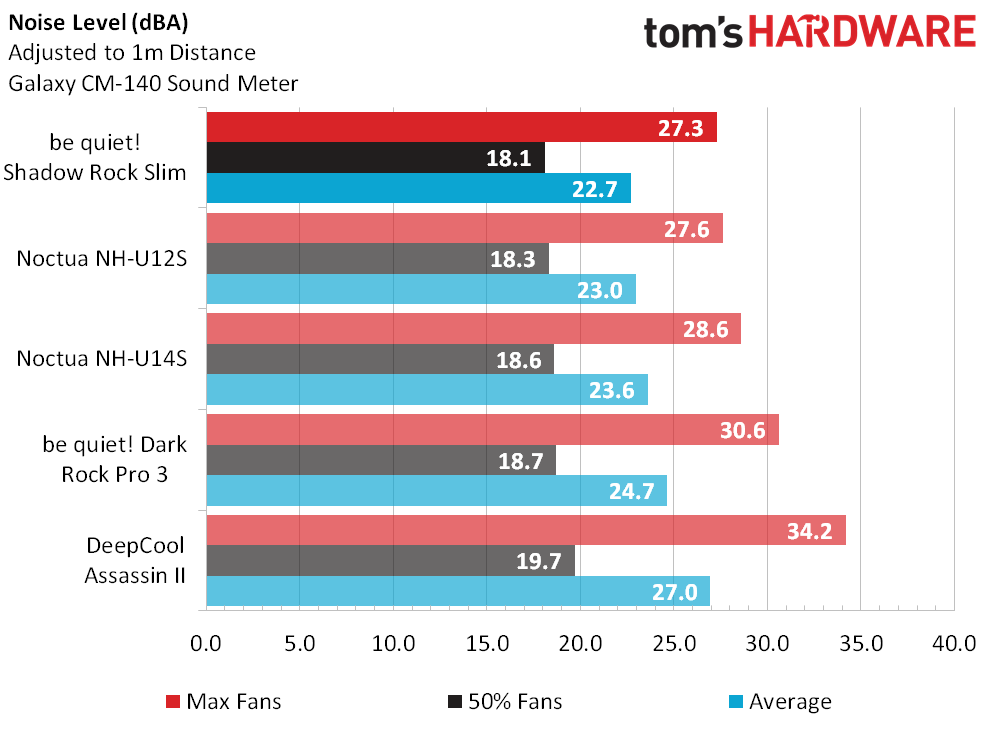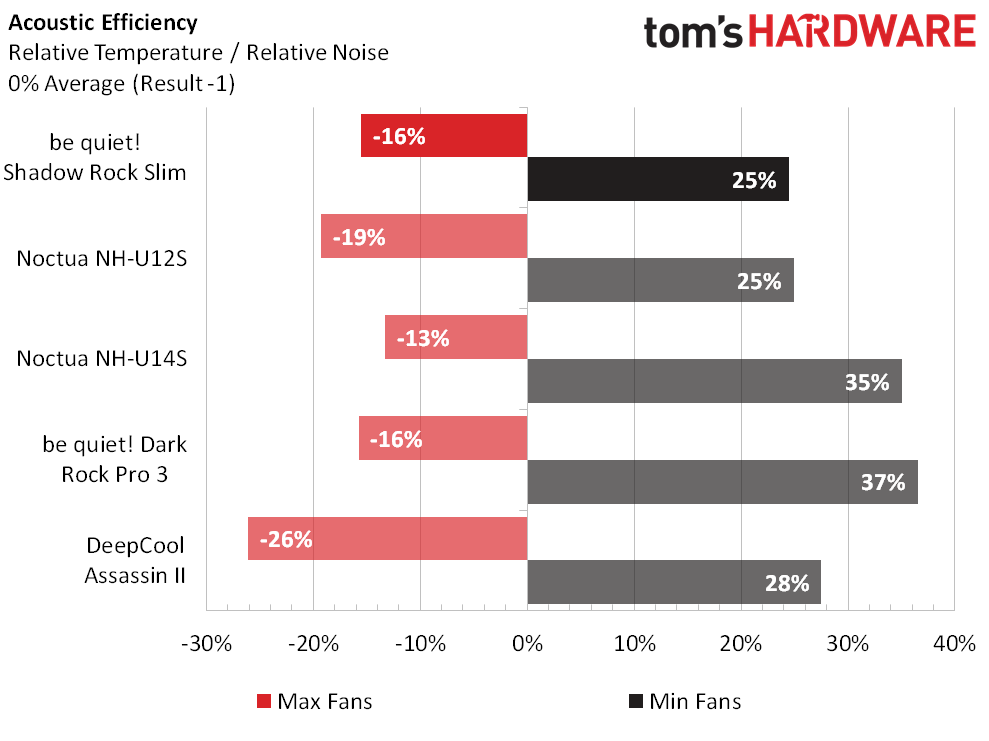be quiet! Shadow Rock Slim CPU Cooler Review
Slim tower CPU coolers make room for both a big fan and memory clearence, but are they powerful enough for an overclocked 6-core Haswell-E CPU?
Why you can trust Tom's Hardware
Test Results And Conclusion
We retain the hardware configuration from previous cpu cooler reviews to make all of our results comparable. The Shadow Rock Slim competes directly against Noctua’s similarly-sized NH-U12S, while its use of an oversize fan required the inclusion of Noctua’s oversized NH-U14S for perspective. Two dual-tower coolers provide even more perspective by showing how much cooling we must give up in order to gain the single-tower conveniences of less crowding and less weight.
The Shadow Rock Slim takes a slight lead in both CPU and voltage regulator (PWM) temperatures compared to the NH-U12S, but that could be completely due to its oversize fan. The NH-U14S also employs an oversize heat sink to reduce CPU temperatures, though the broader fin placement appears to direct some of its extra airflow away from the voltage regulator when compared to the Shadow Rock Slim.
The NH-U12S spins faster at 100 percent duty cycle and slower at 50 percent duty-cycle than either the Shadow Rock Slim or NH-U14S. A larger motor to fan blade ratio is the most likely cause for this discrepancy.
The Shadow Rock Slim has the lowest SPL of any cooler ever tested on this platform, but the NH-U12S isn't far behind.
The "relative average" used to gauge acoustic efficiency is the average of all coolers in this test. Better temperatures and noise levels give the Shadow Rock Slim a slight advantage at full-speed over the NH-U12S, and again it appears that this is mostly due to its slightly oversized fan. Buyers with the space and budget for the NH-U14S will get its "bigger is better" advantage.
The Shadow Rock Slim might not quite reach the performance level of the NH-U14S, but the 50 percent price difference is even harder to minimize. Undercutting even the NH-U12S by $17, Shadow Rock Slim buyers receive huge value dividends.
Excellent performance value is found in the Shadow Rock Slim, but its three-year warranty is only half as long as that of its closest competitor. If the fan fails twice as quickly, the price difference and value lead vanishes with that fan's replacement.
Get Tom's Hardware's best news and in-depth reviews, straight to your inbox.
One could argue that three years is just about long enough for a system to become so "stale" that an at-home builder will replace it, but we can't forget that those outdated PCs often get handed down to someone else. We can only guess at how long any specific fan will last, but three years of factory support on a reduced-price enthusiast product is certainly worth our stamp of approval.
MORE: Best Cooling
MORE: Best CPUs
MORE: Best CasesMORE: All Cooling Content
Thomas Soderstrom is a Senior Staff Editor at Tom's Hardware, covering Cases, Cooling, Memory and Motherboards. Follow him onTwitter.
Follow us on Facebook, Google+, RSS, Twitter and YouTube.
-
Calculatron Be Quiet's mounting system is, overall, nice, but a real pain in the ass to install.Reply
I have seen other reviews, and everyone seems surprised at how well it is able to perform, especially since it is not supposed to cool as well as the full-sized Shadow Rock 2. (Although, it usually seems to surpass it.) -
Crashman Reply17527803 said:Be Quiet's mounting system is, overall, nice, but a real pain in the ass to install.
I have seen other reviews, and everyone seems surprised at how well it is able to perform, especially since it is not supposed to cool as well as the full-sized Shadow Rock 2. (Although, it usually seems to surpass it.)
It's a pain for LGA 2011, but far less of a pain for motherboards that have cooler mounting holes. -
Onus You comment on value, yet I see no mention of prices anywhere in this article. Please include prices.Reply
-
atheus It's a bit surprising you don't have the best-selling (most common) single tower cooler on the market in the mix here. Seems like that would be a pretty valuable data point.Reply -
cknobman ReplyYou comment on value, yet I see no mention of prices anywhere in this article. Please include prices.
$45 @Newegg
http://www.newegg.com/Product/Product.aspx?Item=9SIA68V21E0643 -
Crashman Reply
Perhaps the next time we have one :)17537161 said:Can tom's add the Hyper 212 to the cooler benchmarks? -
Darkbreeze It would be kind of nice to see how the Shadow rock slim, NH-U12S and NH-U14S compare to the Cryorig H5 and H7 as well. If you get the chance to bench those units, please do so as we recommend them often in the forums but are mostly basing performance off reviews that don't have direct comparisons to their actual competition, which are the coolers mentioned here including the EVO.Reply
It would be rather helpful to have comparisons to the less expensive hardware that most users are actually going to probably be inclined to purchase since we know cost is king.
Personally, I have the NH-U14S which is keeping an i7-6700k at about 63°C running Prime v26.6, regardless of how long I run it, with the cooler on the motherboard's silent profile. I really have my doubts about the veracity of the SRS pulling lower PWM temps than the U14S with a smaller fan that's running slower since we know Noctua has one of the best if not the best cooling performance per fan revolution ratios in the industry. I'm impressed if those results are actually accurate (Which I don't mean to be any reflection on you or your testing methods, at all), but I'm just wondering if there isn't SOMETHING that's skewing the results somehow. Different paste, dissimilar paste job, not accounting for different ambients at the time of testing, something.
If that result is accurate, it looks like that cooler is much better than I had believed it to be. Also, if you slide the A15 fan on the NH-U14S down 1/4", it still fully reaches the top but then extends below the heatsink, offering some additional cooling to the VR and VRMs as well as directly cooling the heat pipes before they reach the fin stack. -
Crashman Reply
The voltage regulator isn't changed out at all, and this is temperature delta, so the best I can tell you is that a lower fan blows more-directly on its sinks. Because different boards have different onboard sinks and even the cooler has flexibility in how high the fan can be mounted this is more of a pass-fail validation than a "you should buy for the lower voltage regulator temps". The CPU temperatures are a far more-accurate way to gauge cooling performance.17538505 said:I really have my doubts about the veracity of the SRS pulling lower PWM temps than the U14S with a smaller fan that's running slower since we know Noctua has one of the best if not the best cooling performance per fan revolution ratios in the industry. I'm impressed if those results are actually accurate (Which I don't mean to be any reflection on you or your testing methods, at all), but I'm just wondering if there isn't SOMETHING that's skewing the results somehow. Different paste, dissimilar paste job, not accounting for different ambients at the time of testing, something.
If that result is accurate, it looks like that cooler is much better than I had believed it to be. Also, if you slide the A15 fan on the NH-U14S down 1/4", it still fully reaches the top but then extends below the heatsink, offering some additional cooling to the VR and VRMs as well as directly cooling the heat pipes before they reach the fin stack.








